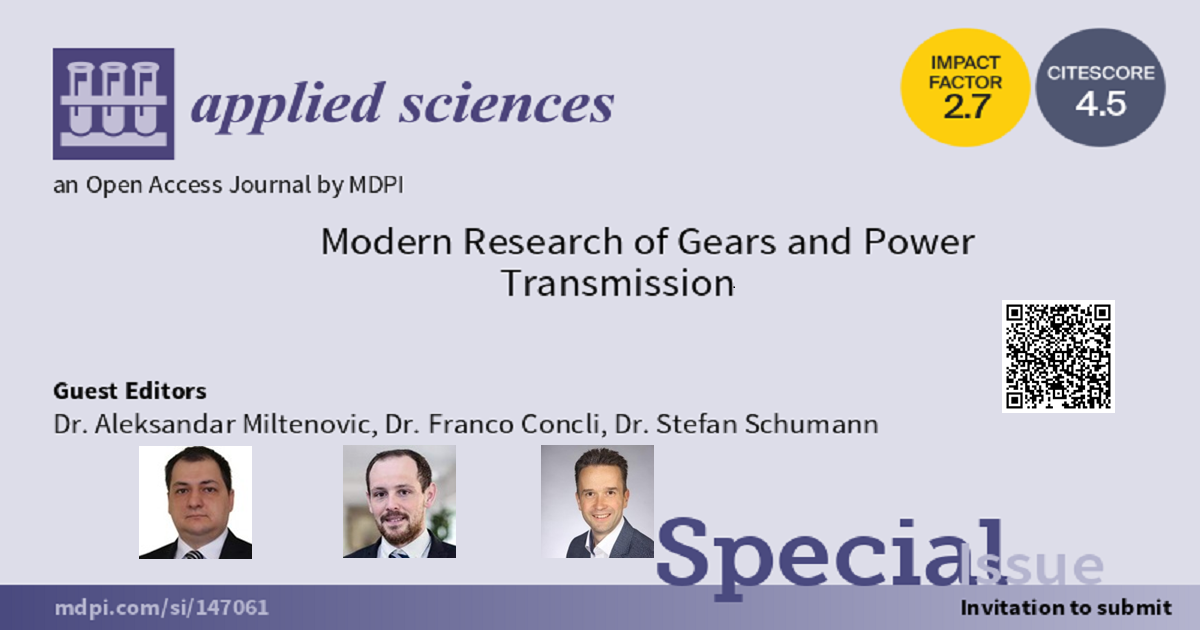Modern Research of Gears and Power Transmission
A special issue of Applied Sciences (ISSN 2076-3417). This special issue belongs to the section "Mechanical Engineering".
Deadline for manuscript submissions: closed (31 January 2024) | Viewed by 11969

Special Issue Editors
Interests: power transmission; gears; finite element analysis; machine elements; mechanical design; product development; 3D printing; tribology; engineering design and product design
Interests: gears; FEM; fatigue; lubrication; efficiency; tribology
Special Issues, Collections and Topics in MDPI journals
Special Issue Information
Dear Colleagues,
This Special Issue is devoted to modern research on gears. To meet the need for better gear performance, a comprehensive understanding of all damage mechanisms and other related physical properties of the used materials and their behavior in real-life applications is required. The purpose of this Special Issue is to present the most recent insights related to the engineering properties of gear types, various materials, modern testing, and use of sensors, including all aspects of their behavior during production and operation. The scope of this Special Issue includes but is not limited to the topics outlined in the keywords.
Dr. Aleksandar Miltenovic
Prof. Dr. Franco Concli
Dr. Stefan Schumann
Guest Editors
Manuscript Submission Information
Manuscripts should be submitted online at www.mdpi.com by registering and logging in to this website. Once you are registered, click here to go to the submission form. Manuscripts can be submitted until the deadline. All submissions that pass pre-check are peer-reviewed. Accepted papers will be published continuously in the journal (as soon as accepted) and will be listed together on the special issue website. Research articles, review articles as well as short communications are invited. For planned papers, a title and short abstract (about 100 words) can be sent to the Editorial Office for announcement on this website.
Submitted manuscripts should not have been published previously, nor be under consideration for publication elsewhere (except conference proceedings papers). All manuscripts are thoroughly refereed through a single-blind peer-review process. A guide for authors and other relevant information for submission of manuscripts is available on the Instructions for Authors page. Applied Sciences is an international peer-reviewed open access semimonthly journal published by MDPI.
Please visit the Instructions for Authors page before submitting a manuscript. The Article Processing Charge (APC) for publication in this open access journal is 2400 CHF (Swiss Francs). Submitted papers should be well formatted and use good English. Authors may use MDPI's English editing service prior to publication or during author revisions.
Keywords
- gear tests (spur, worm, bevel, hypoid, cross-helical, etc.)
- gear damages
- gear dynamics
- operating data acquisition
- gearboxes
- smart gear system/condition monitoring
- novel experimental testing methods
- gear efficiency improvements
- automotive transmission
- gear geometry optimization
- FEM analysis of gear systems
- NVH behavior of gear systems
- EHL contact
- CFD—churning and windage losses
- thermal behavior of gear systems
- new materials for gears
- quality assurance and measurement
- simulation and optimization
- high-speed gears







